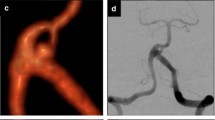Abstract
Background
Despite accumulated experience and improved understanding of the tools, endovascular treatment of intracranial aneurysms continues to have risks linked to the technique itself, and induces procedure-related complications. The purpose of this study was to report our series of stent salvage using the Enterprise stent for procedure-related complication during coil embolization in patients with ruptured intracranial aneurysms.
Methods
Parent artery thrombosis, parent artery dissection, and coil protrusion were considered to be the procedure-related complications. There were 18 consecutive cases (3 unruptured and 15 ruptured aneurysms) with procedure-related complications rescued by the Enterprise stent from December 2008 to December 2011. Follow-up angiography was performed in 14 of the 15 patients with ruptured aneurysms between 6 and 30 months (mean 14.6 months) after the procedure.
Results
The procedure-related complications were parent artery dissection (n = 1), parent artery thrombosis (n = 4), and coil protrusion (n = 10). There was no complication related to delivering or deploying of the Enterprise stent. Initial radiographic results showed 8 cases of complete occlusion and 7 cases of neck remnant. There was no change in the angiographic results during the follow-up periods.
Conclusions
Facing with procedure-related complications during coil embolization of ruptured intracranial aneurysms, the closed-cell designed Enterprise stent might be a useful option for the salvage technique by restoring blood flow and minimizing thromboembolic events.



Similar content being viewed by others
References
Irie K, Negoro M, Hayakawa M, Eayashi J, Kanno T (2003) Stent assisted coil embolization: the treatment of wide-necked, dissecting, and fusiform aneurysms. Interv Neuroradiol 9:255–261
Wong GKC, Wong GKC, Yu SCH, Wong K-T, Poon W-S (2009) Stent salvage for parent vessel coil herniation during intracranial aneurysm embolization. Surg Pract 13:114–118
Shin YS, Kim SY, Kim SH, Ahn YH, Yoon SH, Cho KH, Cho KG (2005) One-stage embolization in patients with acutely ruptured poor-grade aneurysm. Surg Neurol 63:149–154
Dinc H, Kuzeyli K, Kosucu P, Sari A, Cekirge S (2006) Retrieval of prolapsed coils during endovascular treatment of cerebral aneurysms. Neuroradiology 48:269–272
Standard SC, Chavis TD, Wakhloo AK, Ahuja A, Guterman LR, Hopkins LN (1994) Retrieval of a Guglielmi detachable coil after unraveling and fracture: case report and experimental results. Neurosurgery 35:994–998
Fessler R, Ringer AJ, Qureshi AI, Guterman LR, Hopkins LN (2000) Intracranial stent placement to trap an extruded coil during endovascular aneurysm treatment: technical note. Neurosurgery 46:248–253
Lavine SD, Larsen DW, Giannotta S, Teitelbaum GP (2000) Parent vessel Guglielmi detachable coil herniation during wide necked aneurysm embolization: treatment with intracranial stent placement. Neurosurgery 46:1013–1017
Schutz A, Solymosi L, Vince GH, Bendszus M (2005) Proximal stent fixation of fractured coils: technical notes. Neuroradiology 47:874–878
Benitez RP, Silva MT, Klem J, Veznedaroglu E, Rosenwasser RH (2004) Endovascular occlusion of wide-necked aneurysms with a new intracranial microstent (Neuroform) and detachable coils. Neurosurgery 54:1359–1368
Biondi A, Janardhan V, Katz JM, Salvaggio K, Riina HA, Gobin YP (2007) Neuroform stent-assisted coil embolization of wide-neck intracranial aneurysms: strategies in stent deployment and midterm follow-up. Neurosurgery 61:460–469
Fiorella D, Albuquerque FC, Han P, McDougall CG (2004) Preliminary experience using the Neuroform stent for the treatment of cerebral aneurysms. Neurosurgery 54:6–17
Mocco J, Snyder KV, Albuquerque FC, Bendok BR, Alan SB, Carpenter JS, Fiorella DJ, Hoh BL, Howington JU, Jankowitz BT, Liebman KM, Rai AT, Rodriguez-Mercado R, Siddiqui AH, Veznedaroglu E, Hopkins LN, Levy EI (2009) Treatment of intracranial aneurysms with the Enterprise stent: a multicenter registry. J Neurosurg 110:35–39
Chung J, B-s K, Lee D, Kim T-H, Shin YS (2010) Vertebral artery occlusion with vertebral artery-to-posterior inferior cerebellar artery stenting for preservation of the PICA in treating ruptured vertebral artery dissection. Acta Neurochir 152:1489–1492
Siddiqui MA, Bhattacharya JJ, Lindsay KW, Jenkins S (2009) Horizontal stent-assisted coil embolization of wide-necked intracranial aneurysms with the enterprise stent—a case series with early angiographic follow-up. Neuroradiology 51:411–418
Krischek O, Miloslavski E, Fischer S, Shrivastava S, Henkes H (2011) A comparison of functional and physical properties of self-expanding intracranial stents [Neuroform3, Wingspan, Solitaire, Leo(+), Enterprise]. Minim Invas Neurosurg 54:21–28
O’Hare A, Thornton J, Brennan P (2009) Coil migration through a Neuroform 3 stent during endovascular coiling. A case report. Interv Neuroradiol 15:219–222
Lavine SD, Meyers PM, Connolly ES, Solomon RS (2009) Spontaneous delayed proximal migration of enterprise stent after staged treatment of wide-necked basilar aneurysm: technical case report. Neurosurgery 64:E1012
Amenta PS, Dalyai RT, Kung D, Toporowski A, Chandela S, Hasan D, Gonzalez LF, Dumont AS, Tjoumakaris SI, Rosenwasser RH, Maltenfort MG, Jabbour PM (2012) Stent-assisted coiling of wide-necked aneurysms in the setting of acute subarachnoid hemorrhage: experience in 65 patients. Neurosurgery 70:1415–1429
Conflict of interest
None.
Author information
Authors and Affiliations
Corresponding author
Rights and permissions
About this article
Cite this article
Chung, J., Kim, Y.B., Hong, CK. et al. Stent salvage using the Enterprise stent for procedure-related complication during coil embolization of ruptured intracranial aneurysms. Acta Neurochir 155, 223–229 (2013). https://doi.org/10.1007/s00701-012-1528-5
Received:
Accepted:
Published:
Issue Date:
DOI: https://doi.org/10.1007/s00701-012-1528-5




